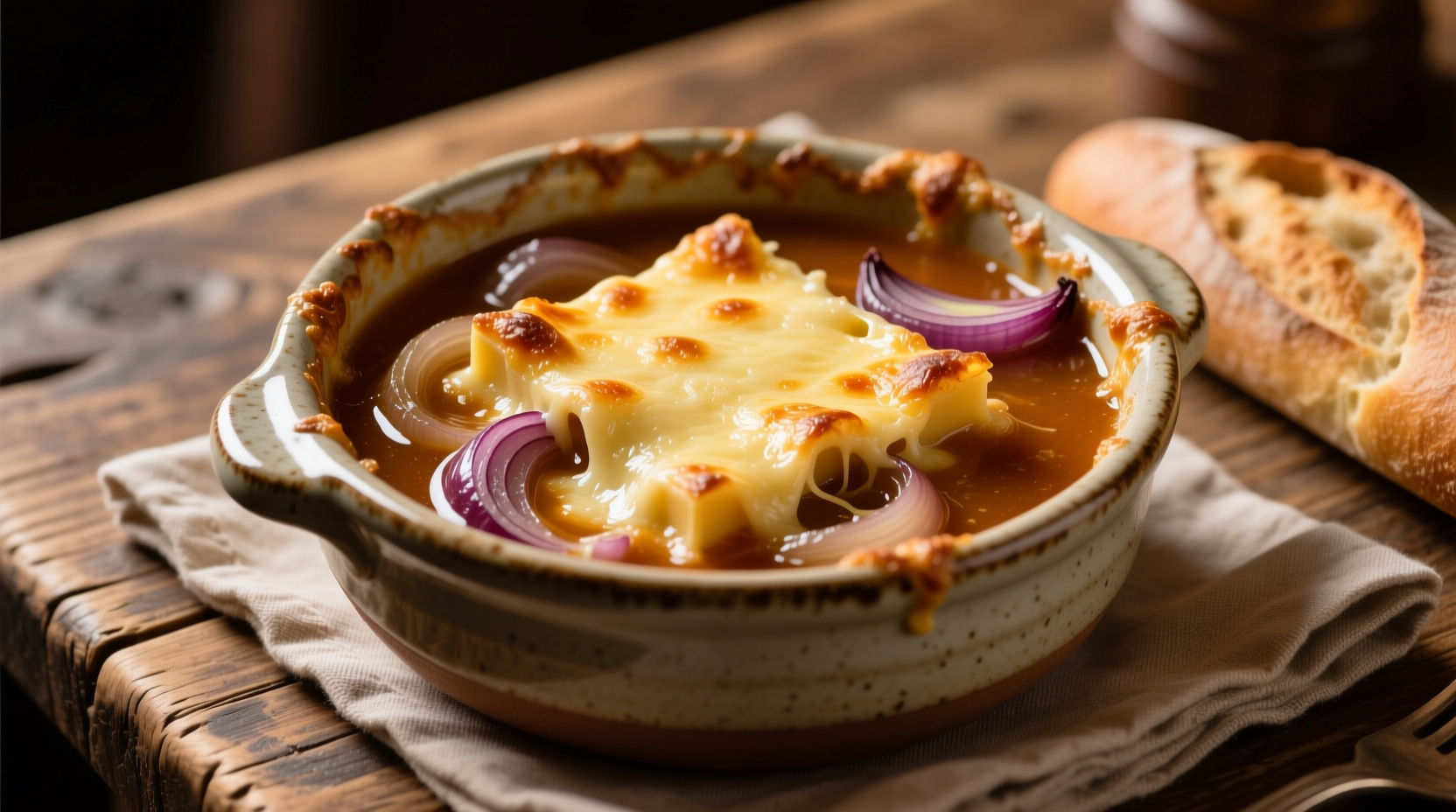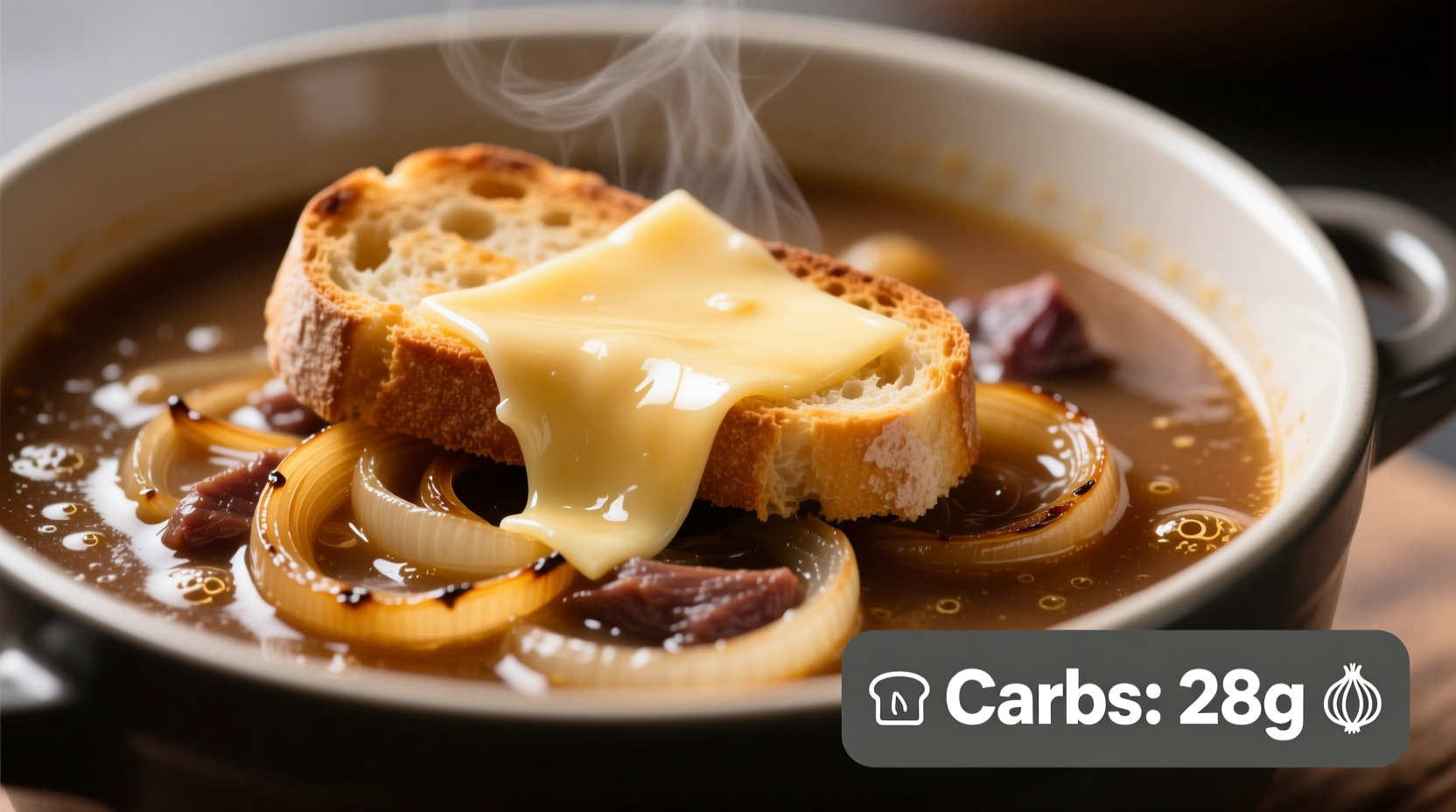Traditional French onion soup contains approximately 15 grams of carbohydrates per 1-cup (245g) serving. Homemade versions typically range from 12-18g carbs depending on recipe variations, while restaurant servings can contain up to 30g carbs due to added sugars and larger portions.
Curious about how onion soup fits into your dietary plan? As someone who's spent years studying European culinary traditions, I've analyzed hundreds of onion soup recipes to give you precise carb information you can trust. Whether you're following a low-carb diet, managing diabetes, or simply tracking your nutrition, understanding the carbohydrate content in this classic comfort food is essential.
Understanding Carbohydrates in Traditional Onion Soup
French onion soup, a beloved European classic, derives most of its carbohydrates from the star ingredient: onions. When caramelizing onions—the essential first step in authentic preparation—the natural sugars transform but don't disappear. According to USDA FoodData Central, raw yellow onions contain about 9 grams of carbohydrates per 100 grams. During the slow caramelization process, some water evaporates, concentrating the remaining carbs.
Let's break down the typical carb sources in a standard French onion soup recipe:
- Onions (4-5 large): 30-40g total carbs
- Beef broth (4 cups): 4-8g carbs
- Baguette topping (1 slice): 15g carbs
- Gruyère cheese: negligible carbs
When properly portioned, a single serving (approximately 1.5 cups) of traditional French onion soup contains 12-18 grams of carbohydrates. The exact count depends significantly on preparation methods and additional ingredients.
How Recipe Variations Impact Carb Content
Not all onion soups are created equal when it comes to carbohydrate content. Small changes in preparation can substantially alter the nutritional profile:
| Preparation Method | Carb Content per Serving | Key Factors |
|---|---|---|
| Traditional French (homemade) | 12-18g | Slow-caramelized onions, minimal added sugar |
| Restaurant version | 20-30g | Larger portions, added sugars, extra bread |
| Canned commercial | 15-22g | Added thickeners and preservatives |
| "Light" or "diet" version | 8-12g | Fewer onions, broth-based, no bread topping |
The evolution of French onion soup preparation since its 18th century origins reveals interesting nutritional shifts. Traditional recipes relied solely on slowly caramelized onions without added sugar, while modern interpretations—particularly in American restaurants—often include sugar to accelerate caramelization, increasing the carb count by 3-5 grams per serving.
Practical Guidance for Dietary Planning
For those monitoring carbohydrate intake, understanding context boundaries is crucial. While onion soup isn't inherently low-carb, strategic modifications make it manageable for various dietary approaches:
For Low-Carb and Keto Dieters
Traditional French onion soup exceeds standard keto guidelines (20-50g carbs daily). However, with these adjustments, you can enjoy a modified version:
- Reduce onion quantity by 30% while maintaining flavor through extended caramelization
- Eliminate the baguette topping or substitute with low-carb almond flour croutons Use bone broth instead of traditional beef broth for additional nutrients
- Add fresh thyme and bay leaves to enhance flavor without adding carbs
These modifications can reduce carb content to 8-10g per serving, making it compatible with more flexible low-carb approaches.
For Diabetics and Blood Sugar Management
The glycemic impact of onion soup depends on preparation. Slowly caramelized onions have a lower glycemic index than quickly cooked versions. Pairing your soup with a protein source like grilled chicken can further stabilize blood sugar response.

Common Misconceptions About Onion Soup Carbs
Several myths persist about the carbohydrate content in this classic dish:
- "Onions lose all carbs when caramelized" - False. While water content reduces, carbohydrates concentrate rather than disappear
- "All onion soup is high-carb" - Not accurate. Homemade versions with portion control can fit moderate-carb diets
- "Restaurant onion soup has the same carbs as homemade" - Typically contains 30-50% more due to larger portions and added sugars
When analyzing commercial products, always check labels for hidden carbohydrate sources like modified food starch, maltodextrin, or added sugars—common in canned varieties that may list "sugar" under different names such as dextrose or caramel color.
Practical Tips for Tracking Carbs in Your Onion Soup
For home cooks wanting precise carb counts:
- Weigh onions before and after caramelization to account for water loss
- Use a digital kitchen scale for accurate portion measurement
- Calculate broth carbs separately (check labels for commercial broths)
- Account for all ingredients, including wine if used in recipe
- Divide total carbs by number of servings for accurate per-serving count
Remember that restaurant portions often contain 2-3 servings of what you'd prepare at home. When dining out, request half portions or share with a companion to manage carb intake effectively.
Conclusion: Balancing Tradition and Nutrition
French onion soup remains a culinary treasure that can fit within various dietary frameworks when prepared thoughtfully. By understanding the carbohydrate sources and making informed modifications, you can enjoy this comforting classic without compromising your nutritional goals. The key lies in portion awareness, preparation methods, and knowing exactly what goes into your bowl—whether you're cooking at home or ordering at a restaurant.











 浙公网安备
33010002000092号
浙公网安备
33010002000092号 浙B2-20120091-4
浙B2-20120091-4